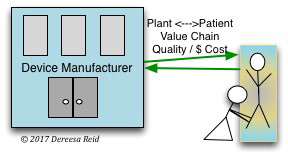
From the Plant to the Patient: Innovation in Value Driven Healthcare
By Dereesa Reid, MBA, CPA
Original Publish Date: May 9, 2017

Most healthcare organizations are focused on value initiatives – increasing quality at a lower cost. Improving patient-centered value is essential to a sustainable competitive advantage. Increasingly, medical device companies are seeking innovative ways to improve “value alignment” with their customers.
Most likely, medical device companies are also re-evaluating answers to traditional marketing questions. Who is the ultimate customer? The physician? The hospital? The patient? What about insurance companies or other payors? Certainly, there are many stakeholders that must be satisfied to ensure success in value based healthcare. So how do medical device companies transform value while serving multiple stakeholders? By venturing beyond the four walls of our organizations with a clear line of sight to the patient, new opportunities for increased value emerge.
In my search of new patient-centered, value opportunities, I decided to explore beyond the walls of the hospital. Prior to becoming a healthcare executive, I began my career in manufacturing including a stint in the semi-conductor industry. The fusion of these experiences sparked an exploratory concept that I coined “from the plant to patient.” My goal was to understand the device manufacturing process and facilitate conversations with engineers and managers regarding inefficiencies that occur from plant through the delivery of the medical device to the patient. Note that this concept could be applied to many types of implanted devices used in elective surgeries.
Our conversations were conducted without regard to “whose side of the fence” the possible savings might occur. As the day’s discussion evolved, it became clear that inefficiency is often interdependent among the manufacturer, the hospital and the surgeon. One of the “ah ha” moments took me back to my early days when I worked with engineers on “plant loadings.” The ideal plant loading involves manufacturing and delivering no more or no less than the customer demands at an optimal time. This is why determining who is the customer is so important yet perplexing for medical device companies.
By focusing on the most important customer, the patient, we discovered new lead times as more surgeons and hospitals adhere to best practice pre-operative screening. Additionally, pre-operative surgical planning software can predict with greater accuracy the type and size of surgical implant required for the patient. This could reduce inventory and ultimately improve production planning for device manufacturers. Unfortunately, medical device companies are often victims of their own sales and service success making a wide variety of types and sizes readily available to the hospital and surgeon. Obviously, it is vital to the quality of care that the device (implant) necessary for the patient is available during surgery! Perhaps, the key words here are necessary for the patient.
Let’s step back for a moment and examine how unnecessary costs accumulate between the plant and the patient. Device manufacturers ensure that hospitals and surgeons have what they want and need typically through consigned inventory or express shipment. Distributers, middlemen, may also be involved adding more cost. Consigned inventory is usually stored in the operating room area. While the hospital is not charged for the inventory until it is used, hospital space, particularly the operating room, is some of the most expensive real estate. If inventory is expressed shipped, distribution costs increase significantly.
Moreover, when additional instrument trays are suddenly required, another layer of inefficiency is created in the hospital’s sterile process department that could lead to delays in the operating room or even quality control breaches due to rushed work activity. These are just a few examples of how unanticipated demand creates inefficiency that ripples across the value chain from plant to patient. Conversely, when stakeholders collaborate early in the patient’s journey, increased lead-time improves production planning and distribution assuring the necessary inventory is available at the optimal time for the patient. This is a win for both cost and quality.
Ultimately, every step that streamlines the path from the plant to the patient creates a potential increase in value. The day that I spent in the manufacturing plant was memorable. We had only scratched the surface of new ways that device manufacturers aligning with stakeholders could increase value from the plant to the patient!
Ms. Reid is a nationally-recognized executive leader in value driven and integrated healthcare systems, with deep experience in all aspects of healthcare administration, spanning from a record of growth in joint ventures, managed care network development, to early adoption and design of bundled payment contracting programs for transplants and joint replacements. Her additional experience in semi-conductor, chemical manufacturing, technology and agriculture serves as a broad foundation of skills solving a variety of business challenges in multiple industries.
She can be reached at dreid@careinfinity.com